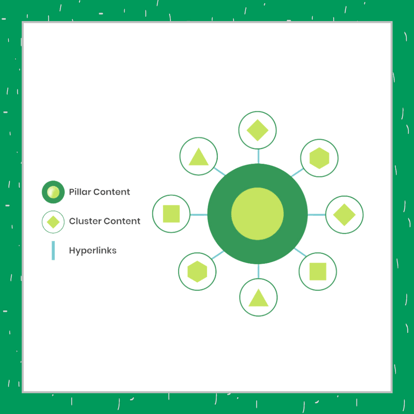Bill Gates said it best in the early ‘90s when he said “Content is King.” But how you leverage your content is just as important. Content clusters provide the contextual support you need so you can get your business out there and in front of the right audience. The overarching goal of content clusters is to provide a deep dive into a topic, while also improving the user experience and SEO of a website.
What is a Content Cluster?
Content clusters are an SEO strategy combined with a content strategy designed to optimize the structure of your website - and its internal linking - by organizing content around topics into pillar and cluster pages. A content cluster uses different levels of web pages to precisely organize content by its relevance to a given topic. Put simply, content clusters are groupings of website content centered around a related topic. Content clusters are at the top of the pyramid, overarching your pillar content, cluster content, and intent-based content. Grouping content through content clusters organizes your website pages into different levels. This structure resembles a family tree of content. This method allows you to use these levels to provide your audience with the most relevant information based on the topics they are searching for.
The History of Content Clusters
So how did this approach to SEO begin? As we mentioned in the intro, “Content is King.” Bill Gates, one of the most famous thought leaders of the late 90s, was definitely on to something when he suggested that most of the money generated on the internet would come from content, much like broadcasting. Even more groundbreaking, Gates suggested content could serve as an equalizer because anyone (and any brand) could create and publish content. As the internet continued to develop, the topic of SEO did too.
Google, who is essentially the ruler of the optimization kingdom, changed its algorithm to favor topic-based content. Some key changes they implemented were keyword stuffing in 2012, semantic search (related terms) in 2013, and mobile ranking in 2015.
With all of these new and improved ways to search for content, HubSpotters Anum Hussain and Cambria Davies jumped in and launched topic cluster experiments in 2016. The extensive findings from their initial topic cluster experiments showed that the more interlinking they did, the better the placement in search engine results pages (SERPs). On top of this, impressions also increased with the number of links they created.
How to Set Up a Content Cluster + Definitions
Pillar Content
 Every pillar page acts as a main hub of content for a broader topic. Think about how foundational pillars are to the architecture of a building - especially in all of Europe’s famous ruins. The same can be said about your website’s pillars. The singular core topic should link to all of your supporting topics. For the best results, pillar pages should be focused on broader subject areas and target general industry keywords with higher search volume.
Every pillar page acts as a main hub of content for a broader topic. Think about how foundational pillars are to the architecture of a building - especially in all of Europe’s famous ruins. The same can be said about your website’s pillars. The singular core topic should link to all of your supporting topics. For the best results, pillar pages should be focused on broader subject areas and target general industry keywords with higher search volume.
Cluster Content
Cluster content is the supporting content that dives deeper into individual topics within your pillar content. Individual pieces of cluster content explore subtopics and will usually target less popular (and less competitive) keywords related to the primary topic.
Intent-Based Information
Think data-driven. All of the content within your cluster should be focused on what your audience is looking for, needs, and intends to find during their online searches. Intent-based data and marketing give you insights into what your target audience is researching, asking, looking for, etc. An intent-based approach to content writing combines data and customer experience so you can meet your audience where they are at with the right content.
The Glue: Hyperlinks
Hyperlinks are the glue that holds pillar content, cluster content, and intent-based content together. Hyperlinking alerts search engines of your pillar page’s authority on the topic, and over time, the page may rank higher for the topic it covers.
Leslie Ye at HubSpot provides super helpful insight in regards to what is good content for clusters and the guardrails differentiating pillar vs. cluster content:
"When considering whether something should be called a pillar page or not, ask yourself this: Would this page answer every question the reader who searched [x] keyword had, AND is it broad enough to be an umbrella for 20-30 related posts? A good sniff test here is — if you’re trying to get the page you’re working on to rank for a long-tail keyword, it’s not a pillar page. If the page you’re working on explores a very narrow topic in great depth, it’s not a pillar page. If the page you’re working on touches on many aspects of a broad topic, it’s probably a pillar page.”
- Leslie Ye
Content Cluster in Action
For example, a lifestyle brand might create a pillar page for Healthy Living. This pillar page is a comprehensive overview of this topic, providing an introduction to more detailed subtopics, or cluster content. This cluster content could range from Eating, Fitness, Mental Health, Sleep Habits, and so on. Each subtopic would be a detailed article or guide that covers the specific topic in-depth and would link back to the "Healthy Living" pillar page. Intent-based content is all of the detailed articles that provide in-depth insight into a particular subtopic, and subsequently pillar page.
Here’s a simple way to visualize the structure:
- Content Cluster of a Lifestyle Brand:
- Pillar Page: (Core Topic) Healthy Living
- Cluster (& Intent-Based) Content: (Subtopics) Fitness, Dietary, Wellness
- [x] Podcasts to Listen to on Your Next Hot Girl Walk
- [x] Nutrition Myths that are Sabotaging Your Health Goals
- [x] Foods & Supplements to Support a Healthier Lifestyle
- How does Meditation and Quiet Time Support Healthy Living?
- The Impact of Mental Health on Achieving a Healthy Life
Capitalizing on Content Clusters + Tips for Success 
Content clusters help you organize, focus, and develop your content strategy. By organizing interconnected content in this way, you can improve not only a better user experience but also the search ranking of your website. Content clusters can help to drive traffic, increase engagement, and establish your business as a trusted expert on a particular topic.
1. Organize
Implementing content clusters will help you organize and streamline your content marketing strategies. Make sure you are aware of what makes a good pillar vs. cluster page. In order to leverage this, your core pillars should align with your products, services, and/or business goals.
2. Focus
Think of your content in terms of topics you want your business to compete in, rather than individual industry keywords that might be performing well. Remind yourself that it should focus on the topic first, then the keywords. Directing your focus toward topics is essential to building a sphere of expertise as opposed to a singular topic of expertise. With this being said it is important to remember that ideal keywords are those with smaller search volumes and less competition, but related intent to the core topic.
3. Develop
More internal links equal a higher placement in SERP. So developing content is crucial to success. On top of this, content clusters give you a better sense of what content is right for you. Don’t muddy the waters or start to compete with yourself. Devote your energy to the topics that resonate with your audience, and work on distributing them across your platforms. Break up your content with images, GIFs, and videos to keep your audience engaged. Evaluate what content clusters are performing well and plan accordingly by developing more content that falls under that umbrella. With this being said patience is key when it comes to developing content clusters and seeing results, so there’s no need to rush the process. Make sure you don’t just call it quits after your first round of content, measure, analyze, learn, adjust, and repeat!
The insight you can gain from implementing content clusters will elevate your inbound strategy and provide an impactful user experience. Content Clusters allow you to streamline your content by creating a seamless search, website, and even social media experience.




